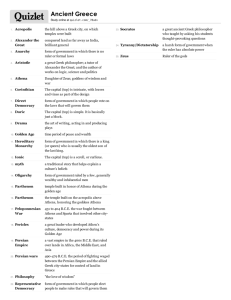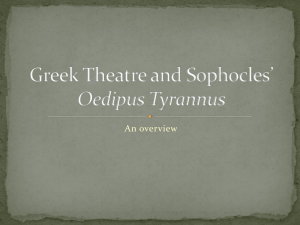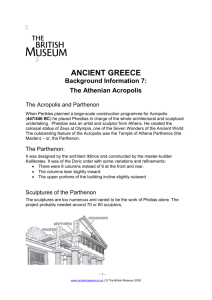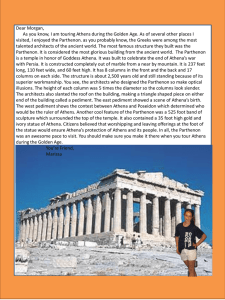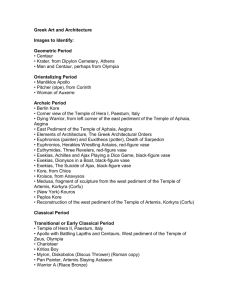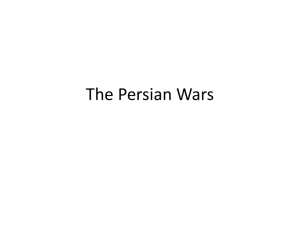Martin Elvery, TMA3, A219 Exploring the Classical World
advertisement
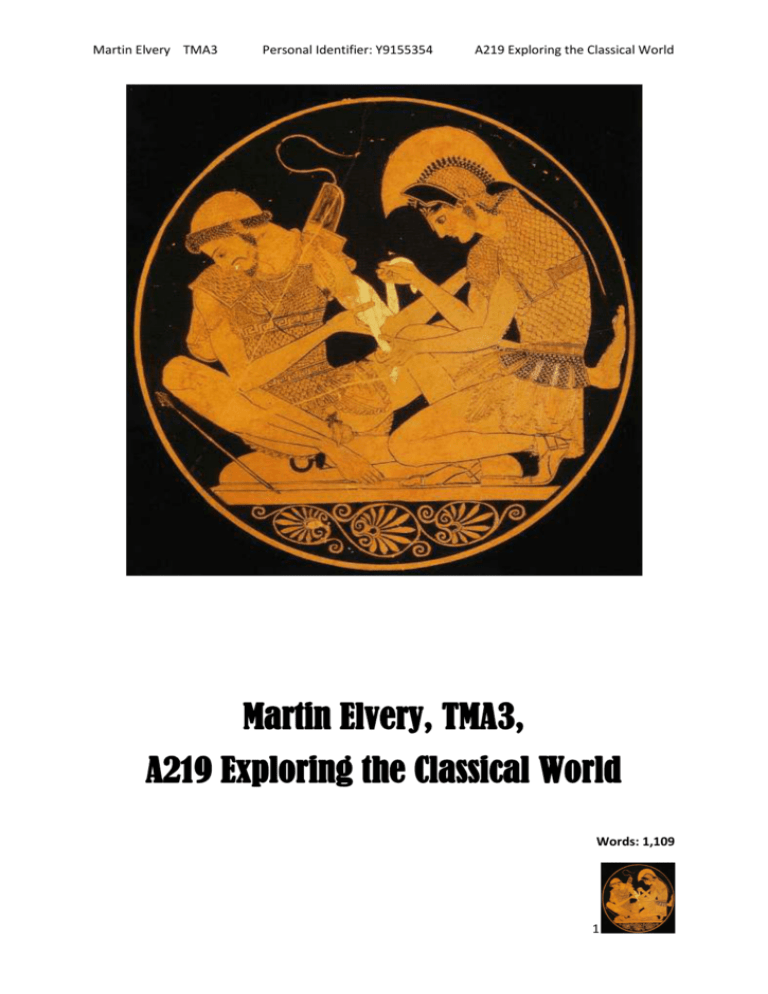
Martin Elvery TMA3 Personal Identifier: Y9155354 A219 Exploring the Classical World Martin Elvery, TMA3, A219 Exploring the Classical World Words: 1,109 1 Martin Elvery TMA3 Personal Identifier: Y9155354 A219 Exploring the Classical World ‘A Conscious program of display?’ Making close reference to the art and architecture of the Acropois, explain and illustrate what is meant by this phrase. Then take any one of the other sources you have studied in block two and briefly analyse the comparisons and contrasts that may be made between this source and the Acropolis in this matter of display. Acropolis translates as high city. The height of the Acropolis meant that it would have had a huge impact on those approaching the city from the attic plain. This was designed to reflect the supremacy of Athens over the surrounding Attic towns and village and indeed its supremacy over all other Greek states as head of the Delian League. (BHAG, pg.169) The height and substance of the Acropolis also symbolised the revival of Athens after its sacking by the Persians and its victory in the Persian wars. (BHAG, pg.169) The walls of the Acropolis would serve as a place of retreat in war time and would have been a powerful symbol that the Persians would never again succeed in levelling the city. The dominance of the Acropolis over the surrounding area was heightened by the fact that sailors rounding cape Sounion could see the glint of sunlight from the spear of the statue of Athena Promachos (BHAG, pg.173) The Acropolis was designed to reflect the fact that the destiny of Athens had been mapped out by the Gods. This is demonstrated in the Erechtheion which was designed to reflect the foundation myth of the city. (Block 2, pg75) Athena had competed with Poseidon for control of Attica and had won. She had chosen the site of the city by supposedly planting an olive tree over which the Erechtheion was built and she was the foster mother of Erechtheus the early king of Athens. In this way, the Erechtheion reflected the idea that the destiny of Athens to be the leader of Greek states and head of the Delian League had been mapped out by the Gods and was therefore justified. This is also reflected in the West Pediment of the Parthenon which depicts Athena fighting Poseidon for control of Attica and in the East pediment which displays the birth of Athena. (Block 2, pg79) (Illustrations Book, plates 33-34) The Acropolis was also designed to reflect and justify Athenian success in the recent Persian wars. This is best reflected in the temple of Athena Nike. Here the goddess is identified with her role as a victor in war:(Block 2, pg. 70) The temple frieze depicts the Athenian victory at the battle of Marathon (illustrations book, plate 9) In mythology Athena had sprung fully armed from the head of Zeus to become the supreme warrior in the war between gods and giants. This was reflected in the great statue of Athena Parthenos (illustrations book, plate 10) which depicted her with shield and spear and holding the winged statue of victory, and also possibly in the Parthenon frieze where the cavalrymen process before the gods, perhaps reflecting a military procession as part of the panathanaia festival to honour the goddess. (illustrations book, plate 35) Athena was therefore a symbol of military victory and reflected and justified the military success of Athens. The Acropolis also sought to give justification for the prominence of Greek culture over foreign nations . In the metopes on the Parthenon we find depictions of the battle of Troy, the Greeks fighting the amazons, lapiths and centaurs and battles between the gods and giants (illustrations book, plates 14-17). The victory of the Greeks in all these conflicts reflected the prominence of Greek culture throughout the known world and would have been a powerful justification for the Athenian empire and for the existence of Athenian colonies overseas as well as for the Greek victory over the Persians. This links in with the portrayal of a sense of Hellenism and Greek unity which is best reflected in the Parthenon frieze. This almost certainly depicts the panathenaia festival procession 2 Martin Elvery TMA3 Personal Identifier: Y9155354 A219 Exploring the Classical World in which subject states eventually took part, and which was accompanied by pan-hellenic athletic contests. (Block 2, pg.95) The frieze may therefore be a deliberate attempt to reflect a shared sense of Hellenic identity amongst the Greek states. Certainly later generations looked back on the period of the Delian League as almost a mythical age of unity amongst Greeks (Essays Book, pg. 93) The Acropolis was also designed to promote and reflect the superior nature of the Athenian system of democracy over Persian despotism, and to encourage civic pride and participation. The Parthenon frieze reflects this by depicting figures which are not easily identified or named and which have no individual features instead they are part of a collective group (Illustrations Book, plate 35). This is further enhanced by the fact that some of the figures are turning round as if to wait for the rest of the procession to catch up with them. There is also a sense of social inclusion here as we appear to have a range of groups from old men to members of the cavalry to women, slaves and even possibly foreigners (metics). This reflects clearly the sense that Athens was an inclusive community in which all groups had their role and purpose. This may have been designed to help Pericles gain support for his democratic reforms. The Acropolis reflects the fact that Athens was a city which properly respected its gods and therefore deserved their favour. The Parthenon frieze probably depicts t the Panathenaia festival in which the citizens presented the goddess with a robe weaved by maidens’ hands (Illustrations book, plate 35) The Acropolis itself was a sanctuary (temenos) and was covered with a series of linked shrines temenoi which would have been used for ritual sacrifices (Block 2, pg.72) This ritual process is itself depicted on the Parthenon frieze. This was a message to Athenians that in order to keep the favour of the gods they had to follow the proper rituals but it was also a justification for the favour that the gods had given to Athens with their success in war, wealth and political participation. Finally, the Acropolis was designed to display, store and justify the wealth of Athens. The treasury of the Athenians was kept in the Parthenon which indicated that the wealth of the city had the blessing of the goddess (BHAG, pg.171) This would have provided a reason why Athens could justify taking tribute from the other cities in the Delian League and why Athens had been blessed with wealth in the form of its silver mines. Also the sheer quality of the drapery and muscle structure of the sculptures around the Acropolis indicates a high level of artistic skills and reflects the cost of the monuments, as does the fact that they were completed in marble. The Parthenon frieze itself was executed by the finest sculptor of the day Pheidias. Thus the Acropolis displayed the fact that Athens could afford the very best. In many ways the play Persians by Aristophanes displays many of the same values and ideals which are communicated in the Acropolis. The importance given to the subject matter is reflected in the fact that all surviving Athenian tragedy is based on mythological subjects apart from Persians (Block 2, pg.24). This can be compared to the frieze on the temple of Athena Nike which is unique in its depiction of a factual subject- the battle of marathon (Illustrations Book, plate 9) It can be seen therefore that Aristophanes was deliberately choosing his subject matter to make a display of the defeat of the Persians. In Persians, the Chorus is a symbol of the weakness and impotence of the Persian empire in contrast to the dynamic and successful Athenian forces which are discussed in the play (Aeschylus, Persians, 457-464). This compares with the display of the inferiority of Persians and other ‘foreigners’ evident in the Parthenon pediments and the Temple of Nike frieze (Illustrations 3 Martin Elvery TMA3 Personal Identifier: Y9155354 A219 Exploring the Classical World Book, Plates 9 and 14-17)The elderly Persian advisers with their excessive lamenting (Aeschylus, Persians, 919-1074), create a sense of the decline of the Persian empire which contrasts with the thrusting confidence of the Athenian empire evident in the Acropolis structures. The presence of the defeated Xerxes in Persians displays all that is wrong with autocratic power. The young, arrogant Xerxes has led his forces to disaster and then has deserted the battlefield (Aeschylus, Persians, 962). and the chorus prostrate themselves in front of the queen in total deference to her autocratic power (Aeschylus, Persians, 155). This contrasts with the display of the strengths of democratic power which is evident in the Parthenon frieze in which all members of the community have their given place and which is clearly associated with Athenian success in the Persian wars judging by the presence of the cavalry in the frieze (Illustrations Book, plate 35) The excessive wealth and decadence of the Persians displayed by the repeated use of the word ‘habros’ in the play (Block 2, pg. 36) contrasts sharply with the social unity and equality displayed in the Parthenon frieze in which Athenians of all classes are part of the same procession. And the prominence of the Persian Queen gives an unthinkable amount of power to a woman. This is contrasted in the fact that the in the Parthenon frieze, women are a small minority (Illustrations Book, Plate 35) Perhaps the biggest form of display in Persians was in the form of the strange foreign clothes worn by the actors. This clearly displayed the differences between Greek and barbarian (Block 2, pg 36). This too is reflected in the Parthenon Metopes in which the Greeks overcome Trojans and amazons and contrasted in the Parthenon frieze in which it has been suggested that metics are integrated into the procession wearing Athenian dress (Illustrations Book, plates 35 and 14-17) It must be said however that Persians in most respects was a less obvious form of display than the Acropolis. On one level Persians simply evokes the disasters that can occur when humans display excessive arrogance, and would have been a lesson to Athenians as well as Persians in this. The tragic story of the loss of so many Persian lives evoked the losses that would have been felt by the Athenians themselves in the Persian wars and was a powerful message about the destructiveness of war. The decline of the Persian empire could have served as an allegory for what might happen to the Athenian empire in the future. Persians therefore works on many different emotional levels and is not simply designed to display the triumph, power and legitimacy of Athenian rule. This effect would have been clear in the performance of the play as all of the actors would have been Greeks and the play would have been performed as part of the city Dyonysia, a religious festival (Block 2, pg.19). It is very likely therefore that the play was designed to have deeper moral and religious meanings than simply to act as a form of triumphal display. In this context in fact it is more likely that the play was designed to evoke sympathy for the defeated Persians and as a comment on the hopelessness of war. 4 Martin Elvery TMA3 Personal Identifier: Y9155354 A219 Exploring the Classical World Bibliography: 1) A219 Readings Book 1, (2006) Milton Keynes: The Open University 2) Budelmann F, Hardwick L, Robson S, (2006) A219 Block 2: ‘Classical Athens’, Milton Keynes: The Open University 3) Pomeroy, S.B., Burstein S.M., Donlan W. and Roberts, J.T. (2004) A Brief History of Ancient Greece: Politics, Society and Culture, Oxford: Oxford University Press 4) Perkins P. (ed.) (2006) Experiencing the Classical World, Milton Keynes: The Open University 5) A219 Illustrations Book, (2007) Milton Keynes: The Open University 6) Chisholm J, Miles L, Reid S, (2002) The Usborne Internet-Linked Encyclopedia of Ancient Greece, London: Usborne 7) Higgins C. (2008) It’s all Greek to me, London: Short Books 5
